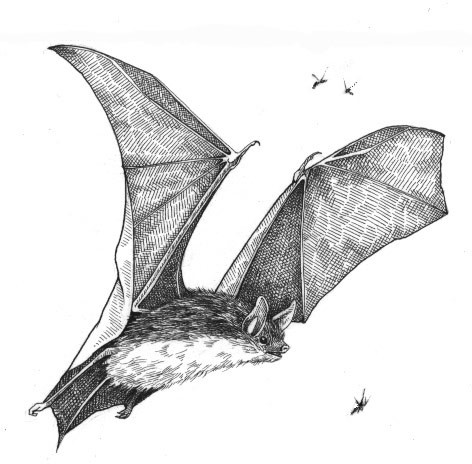
I became interested in bats on a warm June night when I was awakened by a fairly large one flying excitedly back and forth over my bed. Heart racing, I bounded out of the room, slammed the door, and spent the rest of the night on the couch. The bat was nowhere to be seen in the morning when I crept back in, but I knew it was there, hanging by its little bat feet in some inaccessible nook, waiting for nightfall.
Still spooked, I headed for the library to get some perspective. There I learned that it was probably a big brown bat (Eptesicus fuscus), most likely a female ready to give birth. She was not seeking me out to bite my neck, tangle herself in my hair, or give me rabies—merely an expectant mother who, in a state of confusion, had blundered into the house. Though they seem large on the wing, bats are so small and flexible they can squeeze through an opening as narrow as a quarter-inch, the space at the top of a window screen perhaps. A big brown, though four to five inches long with a wingspan of 12 inches, weighs less than an ounce. To get rid of a bat, my sources advised, open all the windows in the room at night, turn the lights out, keep the door closed, and the bat will gladly leave. It worked.
Once my bat was gone, I began to appreciate its more remarkable qualities. The only true flying mammal, bats belong to the order Chiroptera, which means “hand-wing.” The structure of the wing resembles an elongated hand, with a jointed thumb, four jointed fingers, and two layers of skin stretched over the ultra-light bones. Claws on the wings and toes enable bats to hang by their feet or climb walls and tree trunks.
Contrary to popular myth, bats are not blind; they have well-developed sight and hearing. To navigate and capture prey at night, when they are active, bats use echolocation, which is similar to sonar. By emitting ultrasonic calls that are reflected from objects ahead of them, bats can avoid obstacles and find food, even in total darkness. It is said that bats can detect obstacles as fine as a human hair.
Worldwide, there are more than 950 species of bats, nine of them found in our corner of New England. The two most common here are the big brown bat and the little brown bat, which is about three and a half inches long with a wingspan of up to 11 inches. Our bats include the hoary bat, notable for its lush, light brown fur frosted with white tips, and the endangered Indiana bat. While brown bats are year-round residents and hibernate over the winter in caves, mines, or buildings, others, such as the hoary bat, are migratory, flying north for the breeding season and then heading to the southern U.S. or Mexico in the fall.
In New Hampshire and Vermont, most baby bats are born in June. They and their mothers are likely to be part of a maternity colony, a group of 200 or more bats that have been roosting together since the breeding season. After a gestation period of 60 days, big brown bats generally give birth to twins, while the little browns produce a single offspring. Like humans, bats nurse their young from a pair of pectoral breasts. Left in the roost at night while the females fly out to feed, the young begin to fly themselves when they are between three and four weeks old. Big brown bats can live as long as 15 to 18 years, and the little browns—the most common bat in the U.S.—may live up to 33 years.
As humans are discovering, bats play an important role in keeping populations of night-flying insects under control. Large colonies of bats catch literally tons of insects nightly, including beetles and moths that threaten farm crops and forests. The biggest known bat colony—the 30 million bats at Bracken Cave in Texas—consumes more than 200 tons of insects in a single summer evening. And even one little brown bat can catch hundreds of mosquitoes in an hour.
Though people are learning more about bats, the persistence of fear and misinformation—such as the belief that bats carry rabies—often results in the slaughter of these shy, gentle creatures. In fact, only half of one percent of bats have rabies, and rabid bats are not aggressive, but tend to go off and die quietly. Like all wild animals, however, bats should be treated with respect and caution. Anyone encountering an injured bat or having problems with bat colonies should contact a local nature center or the state fish and wildlife or fish and game department for advice.

